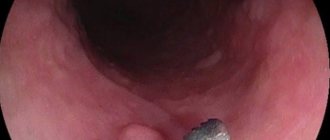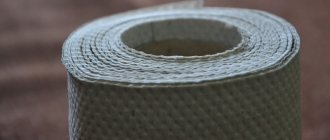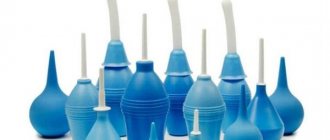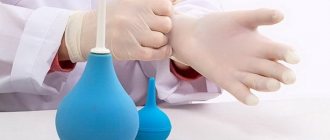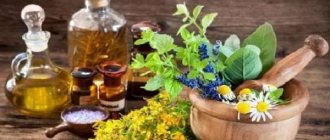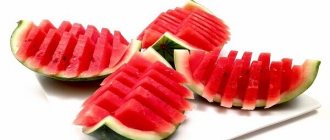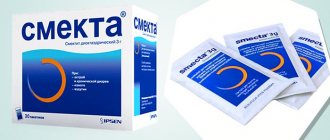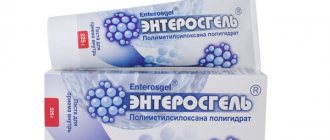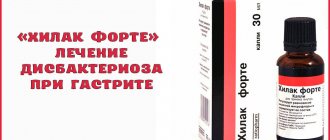Signs indicating an inflammatory process in the intestines
Malfunctions in the gastrointestinal tract are mostly caused by poor nutrition. The predominance of fatty and spicy foods on the menu, regular fast food snacks, a “special love” for smoked meats and soda, even insufficient fluid intake leads to the gradual development of inflammation in the mucous membrane of the large or small intestine. Powerful antibiotic therapy, helminthic infestations and frequent colds, which weaken the immune system, lead to the same deplorable state of the intestines.
Due to the low intensity of inflammatory symptoms, the patient postpones a visit to the gastroenterologist. Gradually developing inflammation covers all large sections of the intestine. Frequently reported complaints from patients:
- The pain is intermittent with a low degree of intensity, and is wandering in nature (it tingles in the stomach here, it hurts here). They usually go away on their own, rarely requiring antispasmodics (No-spa).
- Nausea and bad breath are common signs of intestinal inflammation. The patient's tongue is coated with a thick white coating, and rotten burps are especially unpleasant.
- Flatulence - putrefactive processes provoked by a violation of the intestinal microflora (the rapid development of opportunistic bacteria and viruses against the background of a decrease in the number of beneficial microorganisms), lead to intestinal motility disorders and bloating.
- Disturbed stool - constipation is observed (often characteristic of colitis - inflammation of the large intestine) and diarrhea (observed with damage to the small intestine - enteritis). Some patients note a false urge to defecate and blood in the stool.
- Common symptoms are frequent headaches, increased fatigue, bad mood, lack of appetite, low-grade fever, skin rashes and hair loss.
Urgent consultation with a doctor is necessary if the following abdominal symptoms appear:
- increasing pain (localization - right iliac region - may indicate appendicitis);
- a sharp increase in temperature against the background of worsening symptoms;
- bloody vomiting (it is necessary to exclude bleeding from the ulcer in the duodenum and stomach);
- black stool (a sign of intestinal bleeding).
Therapeutic enemas for intestinal inflammation
Due to the low intensity of inflammatory symptoms, the patient postpones a visit to the gastroenterologist. Gradually developing inflammation covers all large sections of the intestine. Frequently reported complaints from patients:
- The pain is intermittent with a low degree of intensity, and is wandering in nature (it tingles in the stomach here, it hurts here). They usually go away on their own, rarely requiring antispasmodics (No-spa).
- Nausea and bad breath are common signs of intestinal inflammation. The patient's tongue is coated with a thick white coating, and rotten burps are especially unpleasant.
- Flatulence - putrefactive processes provoked by a violation of the intestinal microflora (the rapid development of opportunistic bacteria and viruses against the background of a decrease in the number of beneficial microorganisms), lead to intestinal motility disorders and bloating.
- Disturbed stool - constipation is observed (often characteristic of colitis - inflammation of the large intestine) and diarrhea (observed with damage to the small intestine - enteritis). Some patients note a false urge to defecate and blood in the stool.
- Common symptoms are frequent headaches, increased fatigue, bad mood, lack of appetite, low-grade fever, skin rashes and hair loss.
Urgent consultation with a doctor is necessary if the following abdominal symptoms appear:
- increasing pain (localization - right iliac region - may indicate appendicitis);
- a sharp increase in temperature against the background of worsening symptoms;
- bloody vomiting (it is necessary to exclude bleeding from the ulcer in the duodenum and stomach);
- black stool (a sign of intestinal bleeding).
Treatment of inflamed intestines using traditional methods
It should be understood that no drug therapy or treatment with medicinal herbs and home remedies will give the desired result if a person does not follow a diet.
Diet does not mean giving up food, but balancing the menu, avoiding harmful foods and choosing gentle cooking methods.
When treating intestinal inflammation with folk remedies, the following rules should be observed:
- All treatment prescriptions are discussed with the attending physician.
- Some herbs have serious side effects (for example, yarrow thickens the blood), and sometimes are poisonous (celandine).
- Decoctions of medicinal herbs are taken warm for 2 weeks, then the composition of the raw materials should be changed.
- The effect of home recipes develops gradually, but lasts longer than drug therapy.
Treatment of inflamed intestines using traditional methods
It should be understood that no drug therapy or treatment with medicinal herbs and home remedies will give the desired result if a person does not follow a diet. Diet does not mean giving up food, but balancing the menu, avoiding harmful foods and choosing gentle cooking methods. When treating intestinal inflammation with folk remedies, the following rules should be observed:
- All treatment prescriptions are discussed with the attending physician.
- Some herbs have serious side effects (for example, yarrow thickens the blood), and sometimes are poisonous (celandine).
- Decoctions of medicinal herbs are taken warm for 2 weeks, then the composition of the raw materials should be changed.
- The effect of home recipes develops gradually, but lasts longer than drug therapy.
Causes and symptoms of proctitis
The disease develops as a result of inflammatory processes in the human body or under the pathogenic influence of various microorganisms. The main causes of proctitis include:
- imbalance of intestinal microflora;
- infection by pathogenic microorganisms;
- severe hypothermia of the body;
- injury to the intestinal walls;
- venereal diseases;
- anal sex;
- gastrointestinal diseases;
- intoxication of the body;
- oncological neoplasms.
Did you know? Mikhail Sergeevich: “I can recommend only one remedy for the quick treatment of hemorrhoids” read more.
The symptoms of the disease depend on the form of the disease. The characteristic symptoms of each form of proctitis are presented in the table:
Traditional medicine for proctitis is an affordable, effective and safe treatment of the disease in the early stages.
Before using traditional methods of treating proctitis, you must consult a proctologist.
The most effective and safe home recipes
Red potato tubers are more suitable for this. Juice squeezed from raw potatoes (either with a juicer or by hand) coats the intestinal walls, preventing further irritation and thereby speeding up healing.
Take equal parts of sage, chamomile and yarrow. 1 tbsp. l. The collection is brewed in a glass of boiling water and drunk before meals, warm, half to a quarter glass. This collection quickly eliminates intestinal inflammation and flatulence; after 2–3 weeks of use, stable stabilization of stools is observed (constipation goes away). In the future, you should change the medicinal composition by including calendula, St. John's wort (these plants have anti-inflammatory and healing effects), plantain and mint.
What is colitis, causes and symptoms
Colitis is an inflammation of the colon mucosa and is equally common in both men and women. It ranks second among gastrointestinal pathologies in terms of prevalence.
Causes:
- unbalanced and irregular diet, which causes fermentation processes in the intestines;
- damage by pathogenic microorganisms;
- exposure to chemicals and industrial poisons;
- chaotic use of antibiotics for a long time;
- helminthiasis, infection with various parasites;
- autoallergy, as a consequence of the body’s increased sensitivity to proteins.
Symptoms:
- constant pain in the abdomen, which can be quite severe and has a pulling or wave-like character;
- regular urge to defecate, which does not always result in bowel movement. Often there is a discharge of pus or caustic mucus;
- impurities of blood and pus in the stool;
- persistent constipation or diarrhea;
- increased body temperature, weakness and drowsiness;
- heaviness and bloating, flatulence. They are observed not only after meals, but also on an empty stomach;
- disturbances in the functioning of the liver and gall bladder, which can lead to the development of pathologies.
To treat colitis, medication and diet are prescribed. However, one of the popular and effective ways to cure the disease or alleviate the period of exacerbation is enemas for intestinal colitis.
Why is colonic lavage useful for colitis?
If colitis occurs, the patient is prescribed medication and prescribed a diet. However, the disease is best treated with enemas. In this case, the medicinal compositions easily reach the affected area, wash away bacteria, pus and mucus, and promote the regeneration of damaged mucosa.
So, how to properly do intestinal lavage for colitis and is such treatment effective during exacerbations?
What is colitis, causes and symptoms
Colitis is an inflammation of the colon mucosa and is equally common in both men and women. It ranks second among gastrointestinal pathologies in terms of prevalence.
Causes:
- unbalanced and irregular diet, which causes fermentation processes in the intestines;
- damage by pathogenic microorganisms;
- exposure to chemicals and industrial poisons;
- chaotic use of antibiotics for a long time;
- helminthiasis, infection with various parasites;
- autoallergy, as a consequence of the body’s increased sensitivity to proteins.
Symptoms:
- constant pain in the abdomen, which can be quite severe and has a pulling or wave-like character;
- regular urge to defecate, which does not always result in bowel movement. Often there is a discharge of pus or caustic mucus;
- impurities of blood and pus in the stool;
- persistent constipation or diarrhea;
- increased body temperature, weakness and drowsiness;
- heaviness and bloating, flatulence. They are observed not only after meals, but also on an empty stomach;
- disturbances in the functioning of the liver and gall bladder, which can lead to the development of pathologies.
To treat colitis, medication and diet are prescribed. However, one of the popular and effective ways to cure the disease or alleviate the period of exacerbation is enemas for intestinal colitis.
How effective is it to treat colitis with enemas?
This method is the most effective, since enemas wash out pathogenic bacteria, and medicinal decoctions relieve inflammation and help restore damaged mucous membranes.
Before starting treatment, you should consult your doctor to avoid developing allergies to the components of enemas and other possible side effects.
How to do it right
Lavage is done at night, having previously cleansed the intestines with a cleansing enema. To do this, take a heaped tablespoon of dried chamomile flowers and steam with a glass of boiling water. The infusion is allowed to settle, cooled to a temperature of 30 degrees, and filtered. After this, intestinal lavage is performed.
This is done to wash out the mucus and feces accumulated during the day, facilitating the effects of medicinal decoctions.
The following herbal infusions have shown the greatest effectiveness in the treatment of colitis:
- Take a teaspoon of dry chamomile for a glass of boiling water. Leave for at least an hour. After the infusion has reached room temperature, filter it and add a teaspoon of honey. The composition can be used not only for intestinal lavage, but also as a healing drink.
- Microenemas with medicinal oils have shown high effectiveness. To do this, take 30 ml of rosehip and sea buckthorn oils, 20 ml of peach oil. The resulting mixture is used for intestinal lavage. For the effects of oils to be effective, the patient should lie down for half an hour and then go to the restroom. During this time, the healing composition will have time to be slightly absorbed into the intestinal walls.
- Enemas based on plantain leaves (60 grams), horsetail (40 grams) and dry chamomile (60 grams) showed good results. The herbs are thoroughly mixed and 600 ml of boiling water is poured. The composition is allowed to brew for 2 hours, filtered and used for rinsing.
- A therapeutic enema made from sea buckthorn and rosehip oils is highly effective. Both components are taken equally and injected into the rectum.
- Washing with a mixture of St. John's wort and chamomile soothes the inflamed intestines. Both components are mixed in equal proportions. 2 tablespoons of the resulting mixture are poured into 0.5 liters of boiling water, wrapped in a blanket and left for at least an hour. The resulting infusion is cooled to room temperature, filtered and used as a medicine for rinsing.
Recommendations and tips
When performing enemas, it is important to adhere to the following rules:
- For each new procedure, a fresh portion of a healing decoction or tincture is prepared, as they contain the highest concentration of beneficial substances.
- The most popular component for enemas is dried chamomile flowers. It is important to remember that in some cases this plant can become a strong allergen, so you should consult your doctor before use.
- Enema liquid should be at comfortable room temperature. Too hot or cold formulations can cause pain and worsen the patient's condition.
- Lavage is done at night, having previously cleansed the intestines with a cleansing enema. After this, the required amount of infusion or oils is injected into the rectum.
- Colon lavage is not a complete replacement for drug therapy, although it alleviates the patient’s condition. It is important to stick to your diet and continue the course of medication prescribed by your doctor.
A distinctive feature of enema treatment is that it can be carried out not only during remission, but also when exacerbations occur.
The use of microenemas during exacerbations
During exacerbations, treatment should be carried out especially carefully, since the body's reaction may not always be predictable. Microclysters using oils are the optimal solution, since they do not irritate the inflamed mucous membrane and do not cause discomfort to the patient.
For rinsing, use rosehip oil, flaxseed oil (soothes and reduces pain), sea buckthorn oil (anti-inflammatory effect) and peach oil. These compositions can be used as follows:
- Oil microenema . Take one of the above oils in an amount of at least 100 ml and carefully heat it to 30 degrees, after which it is injected into the colon.
- Oil-water composition. Take 70 ml of oil per glass of boiling water and mix thoroughly. The resulting liquid is allowed to cool to room temperature, then used to rinse the intestines.
You should try to keep the composition in the rectum for as long as possible - this will increase the effectiveness of the treatment.
Therapeutic enemas for colitis in combination with drug treatment and diet can quickly improve the patient’s condition and achieve stable remission. To avoid exacerbation of the disease, it is important to adhere to a healthy lifestyle and not provoke exacerbations.
Source: https://gastritam.net/bolezni/kolit/lechenie-3/promyvanie-kishechnika.html
How effective is it to treat colitis with enemas?
This method is the most effective, since enemas wash out pathogenic bacteria, and medicinal decoctions relieve inflammation and help restore damaged mucous membranes.
Before starting treatment, you should consult your doctor to avoid developing allergies to the components of enemas and other possible side effects.
How to do it right
Lavage is done at night, having previously cleansed the intestines with a cleansing enema. To do this, take a heaped tablespoon of dried chamomile flowers and steam with a glass of boiling water. The infusion is allowed to settle, cooled to a temperature of 30 degrees, and filtered. After this, intestinal lavage is performed.
Recommendations and tips
When performing enemas, it is important to adhere to the following rules:
- For each new procedure, a fresh portion of a healing decoction or tincture is prepared, as they contain the highest concentration of beneficial substances.
- The most popular component for enemas is dried chamomile flowers. It is important to remember that in some cases this plant can become a strong allergen, so you should consult your doctor before use.
- Enema liquid should be at comfortable room temperature. Too hot or cold formulations can cause pain and worsen the patient's condition.
- Lavage is done at night, having previously cleansed the intestines with a cleansing enema. After this, the required amount of infusion or oils is injected into the rectum.
- Colon lavage is not a complete replacement for drug therapy, although it alleviates the patient’s condition. It is important to stick to your diet and continue the course of medication prescribed by your doctor.
A distinctive feature of enema treatment is that it can be carried out not only during remission, but also when exacerbations occur.
Rules and scheme for cleansing the intestines with an enema
Giving yourself an enema at home is a simple procedure. Pay special attention to the solution. It must be cooked correctly. If there is an excess amount of water additive, an allergic reaction may occur. The solution must be at the optimal temperature. Hot or cold water will cause pain.
It is necessary to follow a certain scheme of actions:
- pour the prepared solution or clean water into Esmarch’s cup;
- hang the bowl 50 cm above your height. The tube should point down;
- Lubricate the pre-washed tip with lubricant;
- release air and a little water from the bowl;
- turn off the tap;
- lie on your left side;
- lay an oilcloth or waterproof diaper under yourself;
- bend your knees. This position helps fluid get into places that are hard to reach;
- push the pelvic area back;
- wear disposable gloves;
- insert the tip 4–5 centimeters;
- open the valve that supplies the solution;
- slowly open the valve;
If the liquid entering the intestines causes pain, you should close the tap. The unpleasant sensations are explained by the fact that the intestines are too clogged with feces. You need to inhale and exhale deeply, while moving your stomach from top to bottom. Such manipulations can relieve pain. If the pain has passed, try to retain the liquid inside until the urge to evacuate arises, which cannot be tolerated. After this, perform a bowel movement.
If we talk about children, they are allowed to perform the procedure only after consulting a doctor and strictly following all recommendations. The intestines are not fully formed, and any self-medication can cause complications. If the doctor has prescribed an enema, it should be performed using a rubber bulb. Parents need to remember that an enema cannot be a solution to treating childhood constipation. This will provoke a disruption in the functioning of the intestines, which do not function as in an adult.
Contraindications
An enema for cleansing the intestines is not always useful. An enema can increase the severity of spasms in the intestines. Along with the feces, the injected fluid will be retained. The intestinal walls will stretch, and the pressure inside the abdominal cavity and intestines will increase. If a person has chronic diseases that are in acute form, they will be able to become more active.
If a person undergoes enema frequently, he may get colitis as a side effect.
There are a number of reasons that are strict contraindications for cleansing enemas:
- presence of intestinal obstruction;
- intestinal inflammations that are in the acute stage;
- bleeding of internal organs;
- inflammatory process of the peritoneum;
- a disease that requires absolute rest for the patient;
- haemorrhoids;
- processes of a pathological nature located in the rectum and organs that are adjacent to it (cystitis, cancer, proctitis, etc.).
Knowing how to do an enema to cleanse the intestines at home, you can not only get rid of excess weight, but also improve your condition.
The use of microenemas during exacerbations
During exacerbations, treatment should be carried out especially carefully, since the body's reaction may not always be predictable. Microclysters using oils are the optimal solution, since they do not irritate the inflamed mucous membrane and do not cause discomfort to the patient.
For rinsing, use rosehip oil, flaxseed oil (soothes and reduces pain), sea buckthorn oil (anti-inflammatory effect) and peach oil. These compositions can be used as follows:
- Oil microenema . Take one of the above oils in an amount of at least 100 ml and carefully heat it to 30 degrees, after which it is injected into the colon.
- Oil-water composition. Take 70 ml of oil per glass of boiling water and mix thoroughly. The resulting liquid is allowed to cool to room temperature, then used to rinse the intestines.
Features of performing an enema
Correct administration of a medicinal enema directly affects the effect of this procedure. Because if the medicine is administered correctly, it is quickly absorbed and the effect on the system or organ occurs almost instantly.
A standard enema can be performed either using a rubber bulb or using a Janet syringe, which has a special catheter.
Classification of enemas depending on the composition and principle of action:
- An emollient is used for constipation.
- For a quick pain relief effect.
- For diarrhea, an astringent effect is required.
- Due to the deep state of fainting, when there is a blow to the head with great force or a rush of blood, an irritating enema is given.
- An anthelmintic enema may be given to expel parasites.
The use of oil enemas
During exacerbations of chronic spastic colitis, when you need to empty the intestines gently, without increasing pain, oil enemas are much more effective. To do this, use oil heated to 30-32 degrees in an amount of 200 ml or a water-oil mixture in an amount of 500 ml or more. The liquid is slowly introduced into the intestines using a syringe or an Esmarch mug, while trying not to cause a spasm and to hold it longer. The oil lubricates the walls as it travels up the colon. Dense deposits of feces are separated from the intestinal walls and move smoothly to the rectum.
Types of procedures
They classify therapeutic, siphon and diagnostic enemas; which one is more suitable for the patient depends on the cause of stool retention.
The first type is used when carrying out cleansing, laxative and medicinal manipulations, the second - when preparing the patient for instrumental diagnostics. Therapeutic helps cleanse the intestines of gases and feces, stimulates gastrointestinal motility, and has a local laxative or resorptive effect.
Based on the composition of the solutions, there are several types of effective enemas:
- oil;
- soapy;
- saline, hypertonic;
- with soda solution;
- glycerin enema;
- with lemon juice or vinegar;
- with salt water;
- with hydrogen peroxide 3%;
- Ognev procedure;
- medicinal;
- nutritious.
Those suffering from constipation do not always know which enema is best to give when experiencing intestinal spasms. In such cases, procedures with oils, soda, hypertonic, salty liquid are recommended. For constipation at home, mainly use water, soap or oily solutions. Glycerin, acidic and with the addition of hydrogen peroxide are suitable for stimulating intestinal peristalsis.
A salt enema for constipation helps restore bowel movements in cases of hypertension, body edema, fluid retention in the body, when ordinary cleansing manipulations with water are contraindicated. Table, sea, and sodium salt are suitable for preparing the solution.
Before you do an enema at home, you need to study what temperature the liquid should be. Taking into account the cause of the pathology, a cold, warm or hot procedure is performed. The low temperature composition stimulates peristalsis during paresis, intestinal atony, and has antipyretic properties. Manipulations in the form of an enema with a warm solution relieve intestinal spasms, dissolve feces, and with a hot solution (40–45˚) they increase the urge to defecate in diseases of the pelvic organs in men.
Cleansing
A laxative enema is designed to cleanse the lower colon. During the procedure, feces dissolve and the evacuation function of the intestines is stimulated. Indications for treatment are episodic delays in fecal ejection, preparation for diagnosis, and the inability to independently perform an act of defecation due to hard feces.
For atonic type of constipation, cold water (12–20˚) is filled into a rubber bulb, this increases the motor activity of the digestive tract, weakened due to atony.
In case of spastic stool disorder, the water temperature should be 38–40˚, warm liquid relieves spasms and reduces pain.
A cleansing enema at home is performed using an Esmarch mug. During manipulation, up to 1.5–2 liters of solution is poured into the intestinal cavity. It is impossible to perform the procedure independently, so the patient requires the help of a family member or a medical professional.
Laxative solutions with sea salt
A salt enema for constipation helps reduce acidity, normalize the pH of intestinal microflora, and remove toxins. The active substances slowly dissolve feces, the laxative effect occurs after 15–20 minutes. Therefore, manipulations are carried out before bedtime or early in the morning.
Sea salt enema:
- boiling water – 1 l;
- sea salt – 20 g.
The solution is allowed to cool to a temperature of 42 degrees. Salt water delays the absorption of fluid in the large intestine and prevents feces from hardening. Such procedures are carried out for diseases of the cardiovascular system, edema, weakened peristalsis, dysbiosis of the digestive tract, and arterial hypertension.
A salt enema for constipation helps to normalize stool in an adult while following a strict diet, an unbalanced diet, or disorders of the endocrine system.
Oily
To get rid of constipation at home quickly and gently, you can carry out the procedure with vegetable oil. This product softens compacted feces and lubricates the walls of the rectum, making it easier for feces to move through. The oil helps relieve intestinal spasms and restore weakened peristalsis. Manipulations are allowed even for pregnant women with constipation in the early stages of gestation.
The use of water cleansing enemas
Water cleansing enemas provide a quick effect. For spastic colitis with constipation, do not use cold water, because it can cause intestinal spasms, but heat it to 36 degrees and introduce it into the intestines without pressure, gradually, avoiding premature release of the injected fluid and spasm. Fast-acting enemas, in which the intestines are stimulated due to the amount and temperature of the liquid, are used for atony. Use cool water, 22-23 degrees, with a volume of 0.5-1 liter.
For colitis
In case of exacerbations of spastic colitis, it is necessary to perform a bowel cleansing procedure with an enema. The procedure must be carried out in a gentle manner so as not to cause pain. In some cases, the question arises: is it possible to do an enema with intestinal inflammation? Obviously, not all types of enemas are acceptable in this case. In this situation, an oil enema helps. The material is vegetable oil with a temperature of 32°, in an amount of 0.2 l. You can use a water-oil emulsion up to 0.5 l.
The liquid is injected slowly through a douching device, trying not to cause a spasm and to hold it longer. Lubrication of the intestinal walls occurs, which causes the detachment of dense stool.
Water enemas for intestinal colitis provide quick results. If the disease is accompanied by constipation, use water heated to body temperature. Cold water can cause spasms. When performing water enemas, it is necessary to proceed from the following considerations:
- A therapeutic enema for intestinal inflammation is administered slowly, without pressure, which avoids spasms and ejection of the injected fluid;
- Fast-acting enemas that stimulate the intestines due to the volume of liquid and its temperature are used for atony. 1 liter of room temperature water speeds up emptying;
- Therapeutic enemas are universal: they are prescribed regardless of the form of colitis in order to deliver medicinal substances to the inflamed area of the intestine as soon as possible;
- Pharmacopoeial preparations or homemade aqueous tinctures of calendula, pyrethrum, yarrow, and other medicinal plants are used;
- To ensure a therapeutic effect, the medicine must be completely absorbed. Therefore, the temperature of the solution should be close to body temperature.
Therapeutic enemas
Therapeutic enemas are more universal and are prescribed for all forms of colitis in order to deliver active substances to the inflamed area of the intestine. Pharmaceutical preparations or aqueous infusions of medicinal plants are used (infusions of calendula, yarrow, chamomile, diluted Rotokan). For a therapeutic effect, good absorption is important, so the temperature of the solution should be equal to body temperature, i.e. 37-38 degrees. If the temperature of the solution is higher than body temperature, it will irritate the intestinal mucosa, and the hot solution can burn.
Special indications
Depending on the reason for which a medicinal enema is given, its algorithm may differ slightly. Most often, an enema is prescribed by a doctor to get rid of persistent constipation (when laxatives do not help), for infectious diseases of the rectum, to administer sedatives or sleeping pills.
Enemas are especially helpful in situations where it is not possible to administer any required medication parenterally or intravenously.
Important! The doctor also prescribes a medicinal enema of this type for inflammation of the intestines (a medicinal mixture is made based on collargol and chamomile extract in alcohol), for the treatment of the prostate gland (antipyrine is administered).
Stages of correct setting:
- Agree on the procedure with the patient and tell what will happen and how, what to prepare for. Talk about how the manipulation takes place and what the main features of its implementation are.
- A medical worker must dress in a clean uniform, be sure to disinfect his hands, and wear disposable gloves.
- Heat the selected solution strictly to a temperature of 37-38 degrees, then fill a bulb or a special syringe with it.
- Prepare the surface of the couch by covering it with oilcloth and placing a diaper on top. Help the patient lie on his left side, ask him to bend his knees, and then lift him in this bent position as close to his stomach as possible.
- Lubricate the gas outlet pipe with Vaseline. Also treat a gauze napkin with Vaseline-based oil. Gently spread the patient's buttocks with this napkin and inspect the anus to ensure there is no irritation, ulcers or wounds there.
- Slowly and carefully insert a gas outlet tube fifteen cm deep into the anus. Attach a bulb or a special Janet syringe to the end of the tube. Enter the prepared solution.
- When all the medicine has been introduced inside, you will need to remove the bulb without unclenching it and use a clamp to clamp the tube to remove gases. For the medicine to work, it must be inside for about half an hour, during which time the patient lies on his back.
In principle, the algorithm for administering a medicinal enema cannot be called complex. It is used in cases where it is simply impossible to introduce the medicine into the human body in any other way. Anal administration of any drug ensures active absorption of the drug by the walls of the rectum and the drug almost immediately enters the bloodstream, and then the blood delivers it to the required system or organ.
Important! The process of absorption of drugs for treating the rectal mucosa is fast, but it is not as strong as that of the walls of the stomach. Therefore, doses specifically for an enema are taken a little larger than for normal use.
Enemas with potent drugs must be given carefully and under strict medical supervision so as not to poison the patient. If during the procedure the patient complains of discomfort in the anus, then it is better to stop the enema and conduct an additional examination.
From this material it is clear that if you administer an enema correctly and inject the enema solution inside, then in the end you will be able to influence the problem as effectively as possible and this will help alleviate the condition and speedy recovery. However, it is worth noting that only if performed correctly, such a therapeutic enema is painless, so it is better to practice well first, and then move on to patients.
Preparation of the solution:
- 1 tbsp. Pour 200 ml of boiling water over a spoonful of dried chamomile flowers, cover with a lid and leave for 20-30 minutes in a warm place. Do not boil, strain, use warm.
- Pour 1 teaspoon of a mixture of calendula and yarrow into a glass of boiling water, leave for 20-30 minutes, or pour into a thermos.
- Dilute 1 tablespoon of Rotokan in 0.5 liters of water.
Enemas are administered 1 time (morning) or 2 times (morning/evening) a day, depending on the condition, the course of treatment is 7-21 days.
All about the diet for enemas
When cleansing the body with an enema, it is recommended to completely eliminate:
- white flour and products made from it,
- all fats and margarines,
- cheese,
- eggs,
- dairy products,
- meat and fish,
- fried foods,
- sugar in all forms, including cookies, cakes and other sweets.
Thus, the digestive system is relieved. An easily digestible diet is recommended. You can drink water and natural freshly squeezed juices. You also need to chew each piece thoroughly (35–50 times) while eating.
It is often recommended, depending on your health, to eat only vegetables and fruits, including drinking water and natural juices, during the colon cleansing process.
